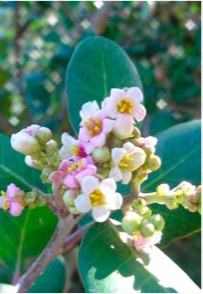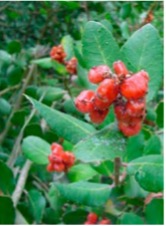FROM THE ARCHIVES: A Glass Of Lemonade-berry-ade
- k-england
- Mar 1, 2022
- 3 min read
Updated: Apr 1, 2022
A Glass Of Lemonade-berry-ade
By Pat Pawlowski, March 2022, originally published in Let’s Talk Plants! March 2011, No.198.

"When life hands you a lemon, make lemonade."
That saying can apply, for instance, to a lemon of a view. To explain: Instead of looking at the neighbor’s yard displaying an old commode artistically filled with faded plastic buttercups, or the big, bloated SUV parked incessantly near your curb – plant a row of lemonadeberry bushes to hide that stuff from view.
Of course, lemonade berry (formal name: Rhus integrifolia) won’t reach the proper screening height overnight, but it does have a moderately fast growth rate. It’s a California native and one of the best landscaping shrubs around; extremely easy-care, drought-tolerant and good-looking at all times. It’s also good for erosion control, and according to the Theodore Payne Foundation for Wildflowers and Native Plants, is fire-resistant.
If you let it, it can grow to 15 feet in height, but if you wish you can prune it to taste. Speaking of taste: the berries that follow the little white/pink flowers are utilized by many birds and mammals.
In fact, this mammal tried to make lemonade from the ripe sticky reddish berries. If you have a strong imagination and are on the way to dying of thirst, the resultant beverage will taste like lemonade. (This is not to say that it isn’t good; it may taste weak to us over-salted, over- sugared, over-artificially-flavored Americans. You know who you are.) No kidding, the flavor does resemble lemonade.

Here’s the recipe courtesy of A Taste of Nature by Kahanah Farnsworth:
Almost Lemonade (Makes 2 quarts)
1/2 cup lemonade berries, cleaned About 1 cup sugar 2 quarts water
Soak the berries in water for 1/2 hour. Remove them and sweeten the remaining liquid to taste. Don’t let the clear color fool you – this drink definitely has a lemon-like flavor. Cheers!
The recipe doesn’t mention the fact that the berries contain Vitamin C, so it is really a healthful drink if you cut down on the sugar. Native Americans knew this. If you are out on a hike, in fact, you can throw some berries into your water bottle to jazz it up a little. And the shrub itself will jazz up your entire garden.
The berries are eaten by birds, including the California Thrasher, which also uses the leaf material for nesting. The Thrasher is a very distinctive-looking brownish bird with a huge downward-curving bill. It uses that bodacious bill to “thrash around” in leaf litter, looking for scrumptious insects. It can belt out the most beautiful sounds – when first I heard it I thought Luciano Pavarotti had landed in the bush outside my kitchen window. It was glorious.
Many types of beneficial insects visit the flowers of the lemonadeberry. Recently I observed honeybees rocking and rolling on the flowers, the bees’ little hind legs encased in what looked like tiny yellow pantaloons, which were really pollen sacs. We stood eyes to eyes; who said bugs aren’t cute? (Of course, if you are allergic to bee stings, you may not want to get that close; but remember that lemonade berry’s flowering season does not last too long anyway.)
So, remember this recipe for a happy day: A glass of lemonade-berry-ade, a comfy outdoor chair and a lemonadeberry bush with its complement of fascinating wildlife visitors.
What a view! (And, if you attract a Thrasher, music too!)




